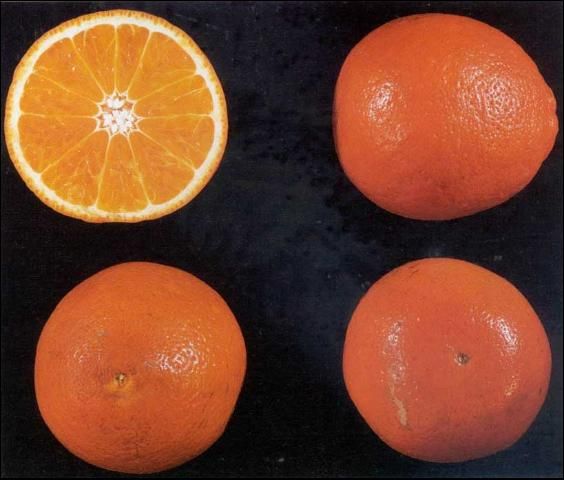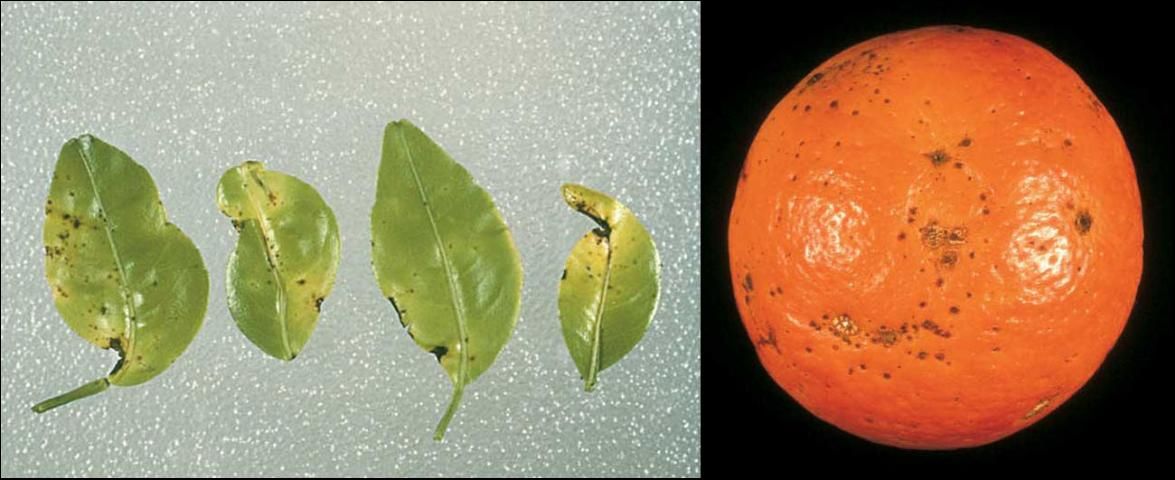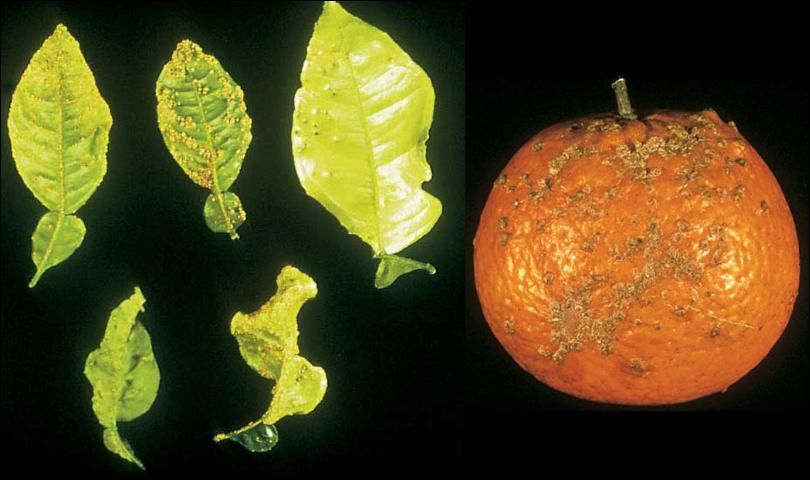The Minneola tangelo (Figure 1) is a Duncan grapefruit x Dancy tangerine hybrid released in 1931 by the United States Department of Agriculture Horticultural Research Station in Orlando. This tangelo (like other tangelo cultivars) is therefore 1/2 tangerine and 1/2 grapefruit. The fruit is quite handsome and a genuine pleasure to eat.

Credit: UF/IFAS CREC
Fruit Characteristics
Most Minneola fruit are characterized by a stem-end neck which tends to make the fruit appear pear or bell-shaped. This appearance has given rise to the name Honeybell in the gift fruit trade, but the proper name remains Minneola. The fruit is usually fairly large, typically 3–3½ inches in diameter. The peel color is quite good and at peak maturity achieves a bright reddish-orange color. The peel is relatively thin, smooth, and tends to adhere to the internal fruit surface. Seed numbers are few, but variable, and range from 0 up to perhaps as many as 15 seeds per fruit. Fruit produced on trees in solid plantings of Minneola are likely to be seedless (or nearly so), while trees in mixed plantings will typically have 7–12 seeds due to the influence of cross-pollination. Minneola is not strongly self-fruitful and yields will be greater when interplanted with suitable pollenizing cultivars such as Temple, Sunburst, or possibly Fallglo.
The fruit matures in the December-February period and has found ready acceptance in the gift fruit trade because of its handsome appearance and excellent eating quality. These same qualities have made Minneola a popular dooryard tree as well.
Tree Characteristics
Minneola trees are quite vigorous, and given adequate room to develop, will make large trees. They tend to be fairly cold hardy, ranking just below its sister cultivar, Orlando. Since the fruit does not mature before the danger of freezes in colder locations of Florida, Minneola would not be a good choice for these areas.
Minneola has been propagated and grown on many rootstocks and most appear to be satisfactory. Cleopatra mandarin is an obvious choice for a rootstock for most tangerines and tangelos and is perhaps the most widely used rootstock. A slightly less vigorous rootstock such as Swingle citrumelo might also be a good choice where ultimate tree size would be a consideration. Fruit quality will always be best on the slower-growing stocks such as Swingle or trifoliate orange. Field observations in some instances where trees are grown side-by-side bear much better on Swingle than Cleopatra.
Cultivation
Minneola will perform much like any other citrus variety and cultural practices should be similar to those recommended for other citrus trees. There are, however, some items which may need special attention on Minneola and they are listed below:
- As previously mentioned, Minneola will develop into a very large tree at maturity and adequate space for development should be provided.
- Minneola is not strongly self-fruitful and low yields will be experienced if suitable pollenizers are not supplied in close proximity and numbers.
- Even when pollenizers are supplied and growing conditions are good, Minneolas will sometimes produce disappointingly small crops, the reason for which is not clearly understood. Since low yields are sometimes a problem, commercial growers often resort to gibberellic acid (GA) growth regulator sprays or girdling the trunk of the tree to increase fruit set and subsequent yield.
- Minneola is subject to Alternaria (Figure 2) and scab fungus (Figure 3) diseases, which may necessitate a vigorous spray program during spring months to prevent damage to leaves and fruit.

Credit: UF/IFAS CREC

Credit: UF/IFAS CREC
In some groves, Alternaria has become quite severe and has reduced crop yields. Leaf infection can also be severe resulting in excessive defoliation.
In locations of severe Alternaria, each flush should be protected with a fungicide to control disease pressure. Trees which are very vegetative due to recent pruning tend to require repeated sprays for disease control where pressure exists.
Despite the aforementioned possible problems, the Minneola is a wonderful fruit and is likely to remain popular due to its excellent eating qualities.
More Information
Florida Citrus Production Guide: Alternaria Brown Spot. https://edis.ifas.ufl.edu/publication/CG021
Florida Citrus Production Guide: Citrus Scab. https://edis.ifas.ufl.edu/publication/CG020
Additional information can be found on Minneola in the following publications:
Saunt, James. 2000. Citrus Varieties of the World. Sinclair International Limited, Norwich, England. p. 78.
Whiteside, J. O. 1986. "Alternaria - Recognition, Prevention and Control of Alternaria Brown Spot on Dancy Tangerines and Minneola Tangelos." Citrus Industry Magazine. 67:44-47,54.